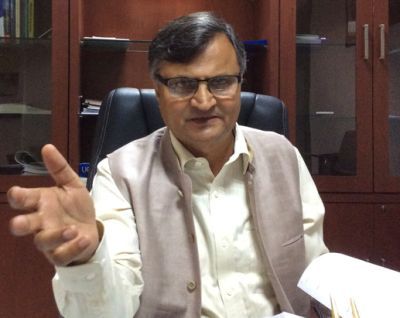'My understanding of the Budget proposal is that a 50 per cent margin will be added to the cost, which lies between A2 and C2'
'It is much more important to expand the effectiveness of MSP as compared to the effect of raising it'
'Implementation is the primary issue for farmers'

The Union Budget announcement of a minimum support price (MSP) that will be 50 per cent more than the cost of production has started a debate on the calculation of cost.
Ramesh Chand, below, member, NITI Aayog, speaks to Sanjeeb Mukherjee on this and related issues.
What is the better cost calculation method for fixing the MSP between A2+FL (actual paid-out cost plus imputed value of family labour) or C2 (comprehensive cost, including imputed rent and interest on owned land and capital)?
Farmers face two types of problems related to the MSP.
The first and more serious one is that the MSP is not implemented in as many as 20 crops out of the 23 for which it is notified.
The implementation itself will greatly support farmers.
There is no point in fixing an MSP at whatsoever level if it is not implemented. So, implementation is the primary issue for farmers. Then comes the margin to be included in MSP.
Second, farmers use family resources such as own land, labour and machinery.
This results in two types of costs. One, those paid in cash or kind by producers for material and services.
This includes material like home-produced seed and farmyard manure, which are treated as purchased from the market.
The second set includes costs not actually incurred by the farmer but imputed for various purposes and to get an idea about the structure of the costs.
This includes the value of own labour and family for the time spent on crop production and the rental value of land.
A2 covers the cost of purchased or own inputs like seed, fertiliser, chemicals, manure, cost of hired and own bullock labour and machine labour, interest on working capital, irrigation expenses, depreciation and rent paid for leased land. Also, cost of repair and any other miscellaneous expense in production of a crop.
C2 is arrived at by adding imputed values to A2.
The Budget has promised an MSP which is 1.5 times the cost of production. What is the ideal cost calculation?
The fair cost according to the economic rationale for providing a margin is A2.
Logically, a margin is not calculated on those costs not actually incurred by a producer.
However, there is a justification to include the imputed cost of family labour to provide a margin, so that family labour is valued 50 per cent higher than hired labour for consideration of the managerial and entrepreneurial skill of a farmer.
Critics say if the MSP calculation is based on A2+FL, farmers will not gain much, as the Centre is already giving this. The real challenge is to provide an MSP which is 1.5 times the C2 cost calculation.
MSP is not anchored to cost on a one-to-one basis.
The basic idea is to provide an incentive to the farmer and ensure the price received by him or her is not less than the cost incurred.
The MSP contains a certain margin over costs, which varies from year to year, depending on many other factors.
You will find the MSP is always above A2+FL, but the extent varies from crop to crop and year to year.
 Depending on the margin, it could turn out to be higher than C2.
Depending on the margin, it could turn out to be higher than C2.
Data for the recent past shows that in a few cases, the MSP has remained lower than C2.
Fixing the MSP higher than 1.5 times A2+FL will turn out to be substantially higher than the existing MSP in a majority of the crops.
An MSP that is at least 50 per cent higher than A2+FL cost will carry a reasonable margin even over C2, except in a few cases.
My understanding of the Budget proposal is that a 50 per cent margin will be added to the cost, which lies between A2 and C2.
It will be higher than A2 by the amount of imputed value of family labour and lower than C2 by the amount of rental value of own land.
And, this should contain a reasonable margin over the sum of paid and imputed cost.
The economic rationale justifies an MSP that includes a 50 per cent margin over A2+FL only.
In my view, there is no economic logic to providing a 50 per cent margin over C2, which includes costs never paid by the farmer.
If the intention of the government was to hoodwink farmers, it could simply say we agree to the suggestion to declare an MSP 1.5 times C2 but without any arrangement to ensure its implementation, as has been the practice in the past 50 years.
However, the Budget is emphatic about ensuring the benefit of the MSP to farmers.
Will there be a big additional financial burden if the MSP is fixed at 1.5 times of the A2+FL cost?
There will definitely be an extra financial burden. The magnitude will depend on many factors, such as the open market price and the method used to implement the MSP.
There is a lot of scope to keep the financial burden low by raising competitiveness in the agricultural market.
Studies, including some done by you, have shown the share of agriculture in overall rural incomes is steadily going down. Then, is there too much focus on MSP and procurement?
Though agriculture now accounts for only a third of the total rural income, it sustains the livelihood of 64 per cent of the rural population.
Agricultural prices have remained depressed and below the MSP in major producing states and major crops.
Higher prices are directly related to the livelihood of cultivators, 41 per cent of the rural population.
Therefore, to provide immediate relief against agrarian distress, it is important to ensure farmers receive prices not less than the MSP and adequately remunerative.
Non-agricultural incomes do constitute a greater portion of total rural incomes, as shown by you in a study released recently. In such a scenario, does the Budget address the issues adequately? If yes, in what way?
To me, it is much more important to expand the effectiveness of MSP as compared to the effect of raising it.
The Budget has taken a holistic approach towards agriculture and the rural economy.
It includes strong initiatives other than MSP to raise employment and income of the rural population.
Farm marketing has been a big problem for many years. How has the Budget tried to address that?
The ultimate solution for low farm income and low prices in agriculture is a modern and competitive system of agricultural markets.
This requires implementation of long-pending reforms to the Agricultural Produce Market Committee (APMC) law and structure.
The mechanism proposed in the Budget to ensure remunerative prices for farmers through direct price intervention should involve implementation of market and other reforms in agriculture by the states.
Farmers in many parts are angry over falling prices. Has the Budget addressed the concern adequately?
Yes, this is the primary focus of this Budget.
Photograph: Rajendra Jadav/Reuters.












 © 2025
© 2025